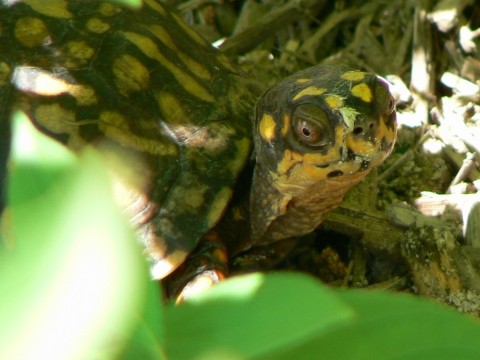Turtles, ancient mariners and terrestrial wanderers, have graced our planet for over 200 million years, sharing the Earth with dinosaurs. These captivating reptiles are integral to the health of ecosystems worldwide, playing roles as predators, prey, and even ecosystem engineers. They contribute to seed dispersal, create habitats for other creatures, and hold deep cultural significance across societies.
{width=480 height=360}The Eastern Box Turtle: A vital seed disperser in forest ecosystems.
While their sturdy shells and seemingly stern expressions might suggest resilience, wild turtles face a multitude of threats, from habitat loss and pollution to illegal collection. Their populations are vulnerable, and conservation efforts are crucial. This raises a common question among pet owners: Can Pet Turtles Be Released Into The Wild? While seemingly a compassionate act, releasing pet turtles into the wild is often detrimental and can have serious consequences for both the pet and the native environment.
The Dangers of Releasing Pet Turtles
Many assume releasing a pet turtle into a natural environment is a kind and liberating act. However, this good intention can lead to unintended harm. Pet turtles, often accustomed to captivity, face significant challenges when released into the wild.
Ecological Disruption: Invasive Species and Disease
Releasing pet turtles can introduce non-native species into local ecosystems. Many pet turtles are not native to the regions where they are kept, and releasing them can establish invasive populations. These non-native turtles can compete with native turtle species for food, nesting sites, and other resources. They may also prey on native species or disrupt the delicate balance of the ecosystem.
Furthermore, pet turtles can carry diseases and parasites that are foreign to wild populations. Releasing them can introduce these pathogens, potentially devastating native turtle populations that have no natural immunity. This disease transmission can have long-lasting impacts on the health and diversity of wild turtle communities.
Survival Challenges for Pet Turtles
Pet turtles are typically raised in controlled environments and are ill-equipped to survive in the wild. They may lack the necessary foraging skills to find food, the awareness to avoid predators, or the resilience to withstand harsh weather conditions.
Unlike wild turtles that gradually learn survival strategies from their parents and environment, pet turtles are suddenly thrust into an unfamiliar and dangerous world. They may struggle to adapt to natural food sources, find suitable shelter, and navigate the complexities of a wild habitat. This often leads to starvation, predation, or death from exposure.
Legal and Ethical Implications
In many areas, releasing non-native species into the wild is illegal. These laws are in place to protect native ecosystems from the harmful effects of invasive species. Releasing a pet turtle could result in legal penalties and fines.
Beyond legal considerations, there is an ethical responsibility to ensure the well-being of both pet turtles and the natural environment. Releasing a pet turtle is often an abandonment, condemning it to a potentially slow and painful death or contributing to ecological damage.
Understanding the Desire to Release
The impulse to release a pet turtle often stems from good intentions. Owners may feel overwhelmed by the long-term commitment of turtle care or believe they are offering the turtle a better life in nature. They might witness behaviors like digging or exploring and misinterpret these as signs of unhappiness in captivity and a longing for the wild.
However, it’s crucial to understand that these behaviors are natural turtle instincts, not necessarily indicators of distress. Providing a spacious and enriching captive environment that mimics aspects of their natural habitat can often satisfy these instincts.
Responsible Alternatives to Releasing Pet Turtles
Instead of releasing a pet turtle, several responsible and humane alternatives exist:
Rehoming and Adoption
If you can no longer care for your pet turtle, rehoming is the most responsible option. Contact local reptile rescues, animal shelters, or herpetological societies. These organizations can help find experienced and caring new homes for your turtle. Online reptile communities and forums can also be valuable resources for finding potential adopters.
Humane Euthanasia (When Necessary)
In cases of severe illness or injury where quality of life is significantly compromised, humane euthanasia may be the most compassionate option. Consult with a qualified veterinarian experienced in reptile care to discuss this option and ensure it is performed ethically and painlessly.
Supporting Turtle Conservation
Channel your concern for turtles into positive action by supporting turtle conservation efforts in the wild. Donate to reputable conservation organizations, volunteer at local nature centers, or participate in citizen science projects focused on turtle monitoring and habitat restoration. Educating others about responsible pet ownership and the importance of turtle conservation is also a valuable contribution.
{width=480 height=270}Bog turtles, like this one in a wetland, are vulnerable and require protected habitats.
Responsible Pet Turtle Ownership
The best way to prevent the urge to release a pet turtle is to become a responsible owner from the outset. Before acquiring a turtle, thoroughly research its specific needs, including habitat requirements, diet, and lifespan. Ensure you are prepared for the long-term commitment, both financially and emotionally, of caring for a turtle that can live for decades.
Never purchase a turtle on impulse. Consider adoption from a rescue organization. Always source your pet turtle from reputable breeders or adoption centers, avoiding the illegal wildlife trade. Creating a stimulating and appropriate captive environment that meets your turtle’s needs is essential for its well-being and prevents the misconception that the wild is a better option for a pet turtle.
Conclusion: Keep Pet Turtles Out of the Wild
Releasing pet turtles into the wild is not an act of kindness but rather a harmful and irresponsible action. It poses significant risks to native ecosystems, the released pet turtle, and can have legal repercussions. Choosing responsible alternatives like rehoming and supporting conservation efforts ensures the well-being of both individual turtles and wild populations. Understanding the commitment of pet ownership and prioritizing responsible care are crucial for protecting these ancient and vital creatures in both captive and wild environments.
{width=480 height=360}Creating nesting mounds for wood turtles: Aiding turtle conservation through habitat enhancement.
Remember, “keeping wildlife wild” includes ensuring pet turtles remain responsibly cared for within appropriate captive settings and never released into environments where they do not belong and can cause harm. Let’s work together to protect turtles, both in our homes and in their natural habitats.

